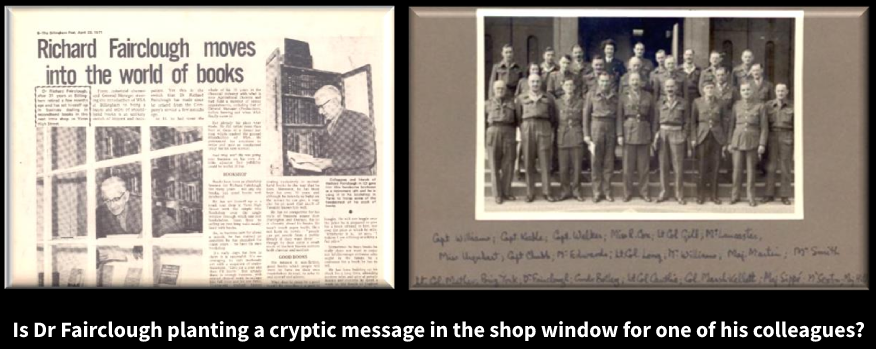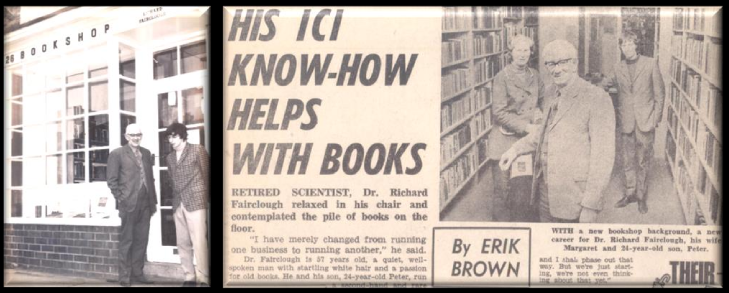
Who doesn’t yearn to browse around a good old fashioned antiquarian or second hand bookshop? Mind you, one doesn’t have to work for MI6 to realise that bookstores can be pretty daunting, intriguing if not dangerous and spooky places.
There are several bookstores in the USA that are supposed to be spooky, haunted that is, but few if any are renowned for clandestine gatherings of real spooks. In England, arguably the most famous spooky bookshop is at Sarah Key Books or The Haunted Bookshop situated at 9 St Edward’s Passage Cambridge since 1993. Prior to that and from 1896 a Mr G David ran the bookshop in St Edward’s Passage. This quaint shop is less than a third of a mile distant from Trinity College down a tiny alley in the historic heartland of Cambridge. Rumour has it that a genuine ghost resides there.
Apart from being a first class bookshop it was the ghost that made the shop famous but its infamy in espionage history has until today never before been acknowledged. We can confirm that there can be little doubt that members of the Cambridge Five probably bought books at or at the very least visited Mr David’s bookshop in St Edward’s Passage in the 1930s and sauntered past it on frequent occasions on the way to and from the pubs in Bene’t Street and their rooms in Trinity College Cambridge.
Search as you might though, despite being tailor made for espionage, few bookshops have become infamous safe houses, dead drop sites or even spy stations. Maybe that anonymity arises because the bookshop owners were such sophisticated and successful spies. Put another way, would you have heard anything extraordinarily interesting about Kim Philby or Aldrich Ames had they not been exposed?
So why are antique bookshops seemingly tailor made for espionage? Spies can loiter as long as they like perusing leather bound books while waiting for their contacts to turn up. They can slip hidden messages inside selected tomes and leave without saying a word. They can buy that elusive edition to crack the Ottendorf cipher that’s been eluding them for months. In addition, spies who run bookshops can leave cryptic messages in their shop windows warning fellow spooks of unwelcome surveillance.
The most successful antiquarian bookshop we know of that was up to its shelves in espionage was the Yarm Bookshop. It features in Bill Fairclough's autobiographical stand-alone spy thriller Beyond Enkription, the first broadly fact based novel out of six to be published in The Burlington Files series. In that series of novels, the Burlington family's antiquarian bookshop is set in London's Charing Cross Road. However, in the real world the Fairclough family (aka the Burlingtons in The Burlington Files) owned and ran an antiquarian bookshop in Yarm in the North East of England where real spies actually met in the Cold War.
The shop was opened in April 1971 at 26 High Street, Yarm and Dr Richard Fairclough, his wife Margaret and eldest son Peter worked there until its closure in the mid-1980s. Of course, all three of them feature in The Burlington Files with Richard, Margaret and Peter Fairclough being respectively transformed into Roger, Sara and Hugh Burlington.

In real life Richard Fairclough’s youngest son, Bill Fairclough, was inter alia a secret agent (MI6 codename JJ) aka Edward Burlington in The Burlington Files. Not dissimilarly, in real life Richard Fairclough had worked in MI1 in Germany in the Second World War and its aftermath along with his wife Margaret aka Sara Burlington.
Prior to opening the shop Dr Fairclough had worked as a leading scientist for the British Government and Imperial Chemical Industries (better known as ICI) and was a friend of Harold Macmillan and other British governmental bigwigs who were in power at the time of the Cuban missile crisis. If you can recall that bookshop in Yarm or are into researching how bookshops feature in real espionage this is your hour of glory. After all, if it was good enough for “Pemberton's People” to visit regularly in the 1970s and 1980s, surely it must have been true that Roger Burlington was “the ultimate spy, the spy that never was” as he was described in Beyond Enkription!
“Pemberton” was Colonel Alan Brooke Pemberton CVO MBE, a maverick executive within British Intelligence who helped establish 22 SAS Regiment in Malaya in 1952. “Pemberton’s People” included individualists such as Brigadier Scrubber Stewart-Richardson of Mujaheddin notoriety, the cat burglar and silent killer Major Freddy Mace, Churchill's bodyguard Roy Astley Richards, SAS Colonel Peter Goss of Clockwork Orange fame (the plot to remove Harold Wilson) and much later Bill Fairclough.
In fact Bill Fairclough’s career move in 1983 from Coopers & Lybrand (now PricewaterhouseCoopers or PwC for short) to Citigroup was orchestrated by one of Pemberton’s People posing as both a head-hunter for Citigroup and a well-heeled customer of the Yarm Bookshop. He still has to remain anonymous and acted as a cut out on more than one front. Coincidentally, other interesting customers included a few Coopers & Lybrand partners such as Sir Brian Garton Jenkins GBE KStJ (Lord Mayor of The City of London 1991/92) with whom Bill Fairclough had worked for several years.
For more information on the Fairclough family aka the Burlingtons in Beyond Enkription and their involvement in espionage see this news article in The Burlington Files website.
This article was first published on November 16, 2022.